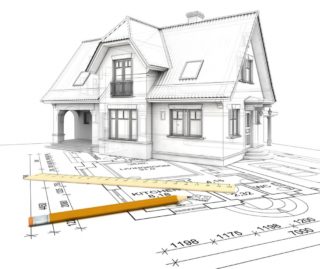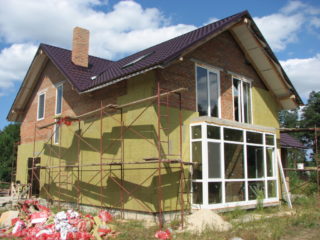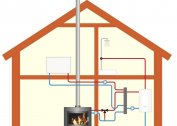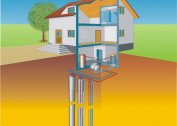Many craftsmen know very well how to save on the construction of a country house, moreover, so that this savings is about half of the estimated funds. Well, in principle, this is not difficult for a professional, because he is not in vain a professional, knows the prices for all the necessary materials, and has the ability to significantly bring them down. At the same time, this is not about cheap materials, that is, low quality, but rather decent materials from which you can build a strong and durable home. For example, you can buy them for future use, in the fall or at the beginning of winter, when discounts are applied to the main assortment, often very significant. Also, the wholesale order affects the price, so it makes sense for the developer to combine with a few more like him and buy in a fold. The more wholesale - the more discounts on goods and transportation.
At the design stage
 You can also save on home planning. Few people do not know that typical projects are much cheaper, and the cost of building such standard houses is also much lower, since nothing needs to be redesigned. And you can save on workers, too, if you hire them out of season to do the work that you can do in the winter — builders usually often get out of work in the winter, so they require less pay if they find a job. The main thing is not to hire workers from the street, otherwise the expected savings here can easily result in a loss of quality and excessive expenses on exceeding the estimate. It is better to hire builders in the same company that developed the project, in reputable companies the management is at least responsible for something, unlike the “shabashnikov”.
You can also save on home planning. Few people do not know that typical projects are much cheaper, and the cost of building such standard houses is also much lower, since nothing needs to be redesigned. And you can save on workers, too, if you hire them out of season to do the work that you can do in the winter — builders usually often get out of work in the winter, so they require less pay if they find a job. The main thing is not to hire workers from the street, otherwise the expected savings here can easily result in a loss of quality and excessive expenses on exceeding the estimate. It is better to hire builders in the same company that developed the project, in reputable companies the management is at least responsible for something, unlike the “shabashnikov”.
In addition, the size of the savings is greatly influenced by the characteristics of the site on which it is planned to erect the building. Ideally, this should be a flat, not hilly area with a low level of groundwater and a shallow depth of soil freezing in winter. Also, when choosing a site, it is advisable to take into account the presence of infrastructure, which involves good access roads to the construction site. If you really want to save on transportation of building materials, then choose a region in which there are factories that produce at least half of what you will build your house from.
There are many more nuances on which you can very well save on the construction of your suburban housing, but this is all one-time saving, so to speak. But there is also the so-called operational savings, when it is possible to save on a properly built house from year to year, until the end of its operation after many decades or even, literally, centuries.
At the heating stage
 So, we all live in a country, a significant part of which is located in the zone of very poor climatic conditions. Based on this, we can state the fact that in winter it is very cold, and therefore the dwellings should be well heated. In Soviet times, there were no problems with this - fuel was worth a penny, you could not spend money on building insulation, the main thing is to open the firebox wider (figuratively). With such housekeeping, a lot of heat went into the atmosphere (literally) through thin walls and holey windows, but it was still warm in the houses, because they did not spare unbelievably cheap fuel.
So, we all live in a country, a significant part of which is located in the zone of very poor climatic conditions. Based on this, we can state the fact that in winter it is very cold, and therefore the dwellings should be well heated. In Soviet times, there were no problems with this - fuel was worth a penny, you could not spend money on building insulation, the main thing is to open the firebox wider (figuratively). With such housekeeping, a lot of heat went into the atmosphere (literally) through thin walls and holey windows, but it was still warm in the houses, because they did not spare unbelievably cheap fuel.
Today, everything has changed dramatically, fuel has risen in price, and therefore there is a need for capital insulation of housing. A good insulation is also not cheap, in addition, even high-quality materials periodically lose their properties and need to be replaced, which involves additional costs, moreover, constant.At the same time, even the so-called “warm” basic building materials, such as wood, foam concrete blocks, slag concrete, do not save - although they better save heat in the house than brick or reinforced concrete, you still can not do without insulation. And having insulated the house with the help of special materials, the problem is not solved until the end - the house still needs to be heated, maybe there will be less fuel, but not by much.
However, experienced professionals know very well how to make a truly “warm” house not only due to warming and heating, but also involving natural, so to speak, factors in this matter. If someone thought about solar panels and windmills, then we are not talking about them. This refers to the following: it is necessary to design the building in such a way (or choose a typical project from a variety of) so that it is exposed to cold air as little as possible, that is, to reduce the cooling of the walls and insulation even in the most severe frosts and winds.
Specific measures
 Firstly, saving again begins with the selection of the site. It is no secret that the stronger the cold winter wind hits the walls of the building, the more they cool, simultaneously cooling the insulation, as a result of which the temperature in the internal rooms drops significantly, and you still have to increase the heating. Therefore, the construction site should not be chosen on the hills dominated by winds. If the terrain is flat, then it is better to build a house among other households that will take up a significant part of the wind load. Therefore, the principle of “my hut from the edge” must be very carefully avoided.
Firstly, saving again begins with the selection of the site. It is no secret that the stronger the cold winter wind hits the walls of the building, the more they cool, simultaneously cooling the insulation, as a result of which the temperature in the internal rooms drops significantly, and you still have to increase the heating. Therefore, the construction site should not be chosen on the hills dominated by winds. If the terrain is flat, then it is better to build a house among other households that will take up a significant part of the wind load. Therefore, the principle of “my hut from the edge” must be very carefully avoided.
Secondly, it is not necessary to build a long and narrow house, since long walls during the wind create a very large vacuum, and cold air masses rush into this zone, cooling the wall with the ensuing consequences. It is better to choose a project of a square house, where the length of the walls is relatively small with a significant area, and the vacuum is so small that it does not contribute to the strong cooling of the walls. But if you nevertheless decided to build a necessarily long house (for example, due to the configuration of the site), then attach any additional rooms to the long walls that will not allow wind flows to accelerate along the walls and cool them.
Thirdly, the premises inside the house must be planned so that all the windows face exclusively on the sunny sides - to the south or east. Thus, even in the most severe frosts, the rays of the sun will penetrate into the premises in a sufficiently large volume and heat the air in them. If everything is correctly calculated and planned, then we can talk about the real "natural" heating of the house, which will not cost you a dime. In many very cold regions of our country, the climate is continental, cloudy weather is a rarity, all day, although relatively short, the sun shines with might and main, and floods the premises with thermal energy. If you put large two-chamber, and even better three-chamber, heat-saving, double-glazed windows in the house, a significant part of the energy for heating the house can be very well saved by heating the building with traditional fuel only at night when the sun is not shining. On those sides of the house where there is no sun, or it appears very rarely, there is no need to put windows at all, but to arrange any technical rooms - storage rooms, a boiler room or a bathroom with a bathtub.
Another good option is to build a veranda on the back of the house. Veranda is an open, "cold" room, which in most cases glazes for the winter. And although it is not heated, the air on the veranda is still much warmer than on the street. Thus, in winter, the veranda can serve as a real buffer between the frosty air and the outer walls of the house itself. And so it turns out that without spending a dime on heating the veranda, you can very warmly insulate the back wall of the building and save on heating.And in the summer, the veranda located in the shadow zone of the house can cool the house very well, and you can also save on air conditioning, while still having a wonderful natural microclimate.
Of course, there are many more nuances, knowing which, you can significantly save on the construction of a low-rise country house and its heating. But even if you take into account those that have already been considered, then you can get such savings that you could not even dream of in the most beautiful dreams. Good luck!


